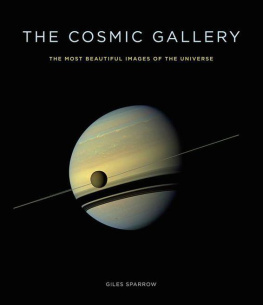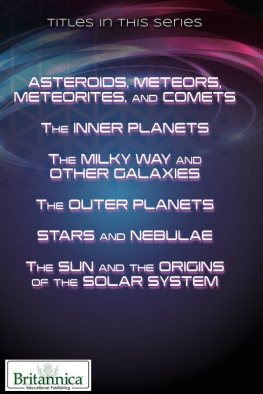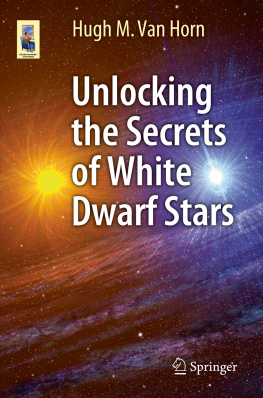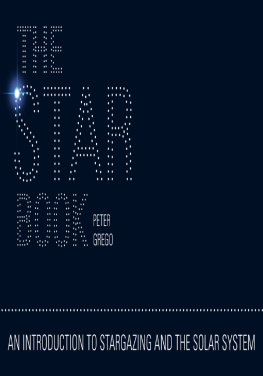Table of Contents
SPACE EXPLORERS
STARS
Giles Sparrow
THE
THE STARS
Sparrow
Titles in the SPACE EXPLORERS series
Visit enslow.com for more information!
ENSLOW
Written in the Stars
A star is a bright sphere of plasma held together by its own gravity.
Each star is born out of the collapse of a cloud of gas and dust called
a nebula. The star develops a core that gives off huge amounts of
energy through its interiorand across outer space. Discover how
collapsing cores become white dwarfs, neutron stars, or even black
holes. You will be amazed at how much drama and energy exist in
the universe!
Giles Sparrow
SPACE EXPLORERS
STARS
THE
Published in 2018 by Enslow Publishing, LLC.
101 W. 23rd Street, Suite 240, New York, NY 10011
Copyright Arcturus Holdings Ltd., 2018
All rights reserved.
No part of this book may be reproduced by any means without the written permission of the publisher.
Library of Congress Cataloging-in-Publication Data
Names: Sparrow, Giles, 1970 author.
Title: The stars / Giles Sparrow.
Description: New York, NY : Enslow Publishing, 2018. | Series: Space explorers | Audience: K to grade 3.
| Includes bibliographical references and index.
Identiers: LCCN 2017031494| ISBN 9780766092655 (library bound) | ISBN 9780766094048 (pbk.) |
ISBN 9780766094055 (6 pack)
Subjects: LCSH: StarsJuvenile literature.
Classication: LCC QB801.7 .S628 2018 | DDC 523.8dc23
LC record available at https://lccn.loc.gov/2017031494
Printed in the United States of America
To Our Readers: We have done our best to make sure all websites in this book were active and
appropriate when we went to press. However, the author and the publisher have no control over and
assume no liability for the material available on those websites or on any websites they may link to. Any
comments or suggestions can be sent by e-mail to customerservice@enslow.com.
Picture Credits:
Key: b-bottom, t-top, c-center, l-left, r-right alexfreire: 16br & 27tl; ESA: 6cr (D Ducros); ESO: 12c (L
Calada), 21b (Y Beletsky); Keck Observatory: 25cr (NRC-HIA, Christian Marois); NASA: 89 (Digitized
Sky Survey, Noel Carboni), 14b & cover/title page br & 31bl, 15tr & 26br (HST/ASU/J Hester et al.),
16c (AEI/ZIB/M Koppitz & L Rezzolla), 18br & 27tr (HST), 22c & 27br (ESA/S Larsen), 24b & 27bl
(ESA/ESO/L Ricci), 25tc & 31br (CXC/M Weiss), 29 tr; Shutterstock: cover & title page main (Tri), tl
(Antares_StarExplorer), tr (mikolajn), cr (Tragoolchitr Jittasaiyapan), 45 (Stefano Garau), 4cl & 31tr
(MaraQu), 4b (Viktar Malyshchyts), 4cr (NASA), 5t (tose), 5br (pixbox77), 67 (My Good Images),
9br (sciencepics), 1011 (ESA/NASA/Herschel/Hubble/DSS), 11tl & 26bl (ESO/VPHAS+ Consortium/
Cambridge Astronomical Survey Unit), 11tc (Egyptian Studio/NASA), 11tr & 26cr (Ken Crawford Rancho
Del Sol Observatory), 1213 (Kalabi Yau), 12br (Jurik Peter), 13tr (sciencepics), 1415 & cover/title page
cl (Jurik Peter), 1617 (Vadim Sadovski), 17br (Catmando), 1819 (Ken Crawford), 2021 (Valerio Pardi),
2223 (Tragoolchitr Jittasaiyapan), 2425 (Giovanni Benintende), 26tl (solarseven), 28b (Denis Belitsky),
29cl (Bill Frische), 29 br (snapgalleria); Wikimedia Commons: 7br & 27tr (NASA/ESA/ G Bacon/STScI),
20c & 27cl (Henryk Kowalewski).
101 W. 23rd Str eet
Suite
New Y ork, NY 1001
USA
enslow.c om
Enslow
P
ublishing
CONTENTS
Introduction ....................................................... 4
Stars ...................................................................... 6
Types of Stars ................................................... 8
Star Birth ............................................................. 10
Star Death ........................................................... 12
Neutron Stars .................................................... 14
Black Holes......................................................... 16
Interstellar Space ............................................ 18
Star Groups ........................................................ 20
Globular Clusters ............................................ 22
Exoplanets .......................................................... 24
Did You Know? ................................................. 26
Your Questions Answered .......................... 28
Glossary .............................................................. 30
Further Information ....................................... 31
Index ..................................................................... 32
Introduction
Our Universe is a huge area of space made up of everything we can see in
every direction. It contains a great number of different objectsfrom tiny
specks of cosmic dust to mighty galaxy superclusters. The most interesting
of these are planets, stars and nebulae, galaxies, and clusters of galaxies.
A star is a dense (tightly packed) ball of gas
that shines through chemical reactions
in its core (middle). Our Sun is
a star. Stars range from red
dwarfs, much smaller
and fainter than the
Sun, to supergiants
a hundred times
larger and a
million times
brighter.
Stars
A planet is a large ball
of rock or gas that
orbits (travels
around) a star. In
our solar system
there are eight
major planets,
several dwarf planets,
and countless smaller
objects. These range
from asteroids and comets
down to tiny specks of dust.
Planets
The space between
the stars is lled with
mostly unseen clouds
of gas and dust called
nebulae. Where they
collapse (fall in) and
grow dense enough to
form new stars, they
light up from within.
Nebulae
A galaxy is a huge cloud of stars, gas, and
dust, including nebulae, held together
by a force called gravity. There are many
different types of galaxy. This is because
their shape, the nature of their stars, and the
amount of gas and dust within them can vary.
Galaxies
Gravity makes galaxies bunch together to form
clusters that are millions of light-years wide.
These clusters join together at the edges
to form even bigger superclustersthe
largest structures in the Universe.
Galaxy Clusters
This is our home galaxy, the Milky
Way, seen from Earth. Our view of the
Universe depends on what we can see
using the best technologies that we have.
Almost every light you see in the night sky is a star
(apart from satellites or aircrafts). Stars are the only objects
in the Universe that truly shine, or make their own light.
Everything else, from planets to glowing clouds of gas,
is only reecting or absorbing (taking in) starlight.
A star is simply a huge ball of gas that shines by changing
light chemical elements (usually hydrogen) into heavier









